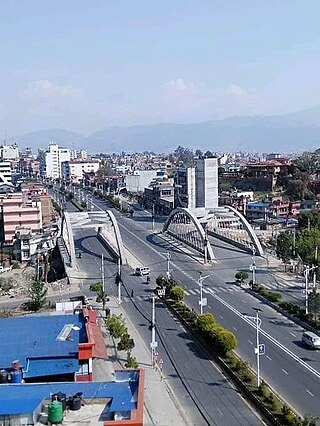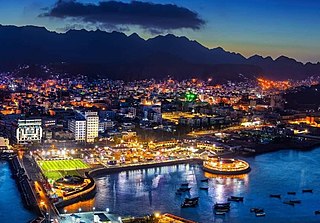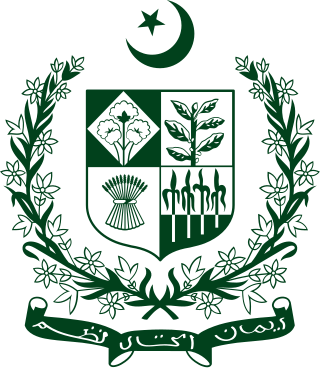
The economy of Morocco is considered relatively liberal, governed by the law of supply and demand. Since 1993, in line with many Western world changes, Morocco has followed a policy of privatisation. Morocco has become a major player in African economic affairs, and is the 6th largest African economy by GDP (PPP). The World Economic Forum placed Morocco as the most competitive economy in North Africa, in its African Competitiveness Report 2014–2015.

The economy of Nepal is a developing category and is largely dependent on agriculture and remittances. Until the mid-20th century Nepal was an isolated pre-industrial society, which entered the modern era in 1951 without schools, hospitals, roads, telecommunications, electric power, industry, or civil service. The country has, however, made progress toward sustainable economic growth since the 1950s. The country was opened to economic liberalization, leading to economic growth and improvement in living standards when compared to the past. The biggest challenges faced by the country in achieving higher economic development are the frequent changes in political leadership, as well as corruption. Nepal has consistently been ranked as one of the poorest countries in the world.

The economy of Yemen has significantly weakened since the breakout of the Yemeni Civil War and the humanitarian crisis, which has caused instability, escalating hostilities, and flooding in the region. At the time of unification, South Yemen and North Yemen had vastly different but equally struggling underdeveloped economic systems. Since unification, the economy has been forced to sustain the consequences of Yemen's support for Iraq during the 1990–91 Persian Gulf War: Saudi Arabia expelled almost 1 million Yemeni workers, and both Saudi Arabia and Kuwait significantly reduced economic aid to Yemen. The 1994 civil war further drained Yemen's economy. As a consequence, Yemen has relied heavily on aid from multilateral agencies to sustain its economy for the past 24 years. In return, it has pledged to implement significant economic reforms. In 1997 the International Monetary Fund (IMF) approved two programs to increase Yemen's credit significantly: the enhanced structural adjustment facility and the extended funding facility (EFF). In the ensuing years, Yemen's government attempted to implement recommended reforms: reducing the civil service payroll, eliminating diesel and other subsidies, lowering defense spending, introducing a general sales tax, and privatizing state-run industries. However, limited progress led the IMF to suspend funding between 1999 and 2001.
From 1947 to 2017, the Indian economy was premised on the concept of planning. This was carried through the Five-Year Plans, developed, executed, and monitored by the Planning Commission (1951–2014) and the NITI Aayog (2015–2017).
Nepal relies heavily on foreign aid, and donors coordinate development aid policy through the Nepal Development Forum, whose members include donor countries, international financial institutions, and inter-governmental organizations. Japan is Nepal's largest bilateral aid donor, and the World Bank and Asian Development Bank are the largest multilateral donors. Donors have been reported as losing confidence in Nepal as a result of political interference and corruption in poverty relief efforts as well as the country's apparently poor capacity to utilize aid. According to World Bank figures, official development assistance increased from US$8.2 million in 1960 to US$369 million in 2003 and then fell to US$177 million in 2004. According to Nepal's Ministry of Finance, total foreign aid committed in fiscal year (FY) 2003 was US$555 million, with 63.3 percent in grants and 36.7 percent in loans. In FY2004, total foreign aid committed was US$320 million, of which 37.7 percent was grants and 62.3 percent, loans. In June 2004, active World Bank credits totaled US$302 million, with the greatest portions allocated to the financial sector and to energy and mining. By the end of 2012, the outstanding World Bank IDA loan totaled $ 1.48 billionArchived 2015-05-05 at the Wayback Machine.
The Five-Year Plans of Vietnam are a series of economic development initiatives. The Vietnamese economy is shaped primarily by the Vietnamese Communist Party through the plenary sessions of the Central Committee and national congresses. The party plays a leading role in establishing the foundations and principles of communism, mapping strategies for economic development, setting growth targets, and launching reforms.
On the eve of the Mongolian Revolution of 1921, Mongolia had an underdeveloped, stagnant economy based on nomadic animal husbandry. Farming and industry were almost nonexistent; transportation and communications were primitive; banking, services, and trade were almost exclusively in the hands of Chinese or other foreigners. Most of the people were illiterate nomadic herders, and a large part of the male labour force lived in the monasteries, contributing little to the economy. Property in the form of livestock was owned primarily by aristocrats and monasteries; ownership of the remaining sectors of the economy was dominated by Chinese or other foreigners. Mongolia's new rulers thus were faced with a daunting task in building a modern, socialist economy.
The Indian government has, since war, subsidised many industries and products, from fuel to gas.
The Sampoorna Grameen Rozgar Yojana was a scheme launched by the Government of India to gain the objective of providing gainful employment for the rural poor. From 21 February 2003, EAS became an allocation-based scheme. The programme was implemented through the Panchayati Raj institutions.
At the time of its founding, the People's Republic of China was one of the poorest countries in the world. In the early 1950s, its industry developed rapidly through a state-led process heavily influenced by the Soviet experience. Aiming to close the gap between its political ambitions and its phase of development, China began the Great Leap Forward, which sought to even more rapidly industrialize the country. The effort largely failed, and its policies contributed to famine.

Cambodia was a farming area in the first and second millennia BC. States in the area engaged in trade in the Indian Ocean and exported rice surpluses. Complex irrigation systems were built in the 9th century. The French colonial period left the large feudal landholdings intact. Roads and a railway were built, and rubber, rice and corn grown. After independence Sihanouk pursued a policy of economic independence, securing aid and investment from a number of countries.
Mexico, a classified arid and semi-arid country, has a total land area of 2 million square kilometres, 23% of which is equipped for irrigated agriculture. The agricultural sector plays an important role in the economic development of the country accounting for 8.4 of agricultural gross domestic product (GDP) and employing 23% of the economically active population. Irrigated agriculture contributes about 50% of the total value of agricultural production and accounts for about 70% of agriculture exports. Mexico's government initiated a number of structural reforms in the water sector aimed to introduce modern water management and irrigation.

The Five-Year Plans for the National Economy of Pakistan, were the series of nationwide centralised economic plans and targets as part of the economic development initiatives, in the Pakistan. The plan was conceived by the Ministry of Finance (MoF), and were studied and developed by the Economic Coordination Committee (ECC) based on the theory of Cost-of-production value, and also covered the areas of Trickle-down system. Supervision and fulfillment of this programme became the watchword of Pakistan's civil bureaucracy since early 1950s.

In Nepal, the economy is dominated by agriculture. In the late 1980s, it was the livelihood for more than 90% of the population. Although only approximately 20% of the total land area was cultivable.

The economic history of Morocco has largely been charted by the national government through a series of five-year plans. Centralized planning has gradually given way to moderate privatization and neoliberal economic reforms.

Prior to 1979, Iran's economic development was rapid. Traditionally an agrarian society, by the 1970s the country had undergone significant industrialization and economic modernization. This pace of growth had slowed dramatically by 1978 as capital flight reached $30 to $40 billion 1980 US dollars just before the revolution.
The Pakistan federal budget of 2010–2011 has been prepared in accordance with the budgeting and accounting classification system that has been approved by the Government of Pakistan as an integral part of the New Accounting Model.
The Pakistan federal budget of 2009–2010 has been prepared in accordance with the budgeting and accounting classification system that has been approved by the Government of Pakistan as an integral part of the New Accounting Model. This is the first year the federal budget is being prepared using the newly adopted Medium-Term budgetary Framework (MTBF). Under this method macro projections are made over a rolling 3-year budgetary horizon. This year, expenditure ceilings were issued to Ministries on recurrent budget after Cabinet's approval, in line with the Government's stated priorities.
The Five Year Plans of Bhutan are a series of national economic development plans created by the government of Bhutan since 1961.
This article discusses the economic history of Sudan.







